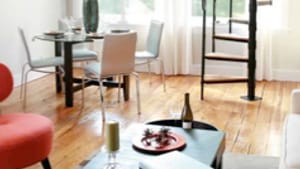Stay in the Loop
BSR publishes on a weekly schedule, with an email newsletter every Wednesday and Thursday morning. There’s no paywall, and subscribing is always free.
My home, my museum, or: How to handle ‘a woman's third crisis'
The home as art: practical advice

In "On buying art in Philadelphia," Victoria Skelly chastised Philadelphia Magazine for giving bad advice on how to decorate your home with art. I would chastise her review for the same reason.
Although Skelly presents some good arguments against copycat approaches to residential design, in conclusion she fails to provide any helpful guidance. Her single concrete example of fine design is her own home, where she started her project with artworks inherited from her artist father. How does this advice help the reader whose relatives are not accomplished artists?
After warning us away from professional support, Skelly insists you should discover your identity entirely on your own, and assures BSR readers that the rest of home design "should follow quite naturally. It should organically emerge."
Professional designers and consultants like me know that the great majority of homeowners are seriously challenged at expressing their own creative style. That's why they hire us. But why can't they just buy art objects and furnishings (as Skelly suggests) and make the same kind of personal statement that they achieve when they buy a party dress or necktie?
Too many conflicting goals
The reason is: because the goals of residential design are complex and often conflicting. Physical and psychological comfort, everyday efficiency, aesthetics, and personal style don't just naturally go together. Trying to meet all these goals at the same time, in a three-dimensional space that constantly changes "“ that's a very tall order.
Cost is big factor as well. When you enter the realm of aesthetics, it's easy to make major financial mistakes— like, say, buying "indispensable" gadgetry that makes your home office ugly, or discovering that your new super-sofa won't fit through your front door.
Painted ladies in girdles
Perhaps the most costly mistake involves trying to decorate spaces that are architecturally flawed to begin with. Such rooms, improperly designed, can look like over-painted fat ladies squeezed into too-tight girdles.
Psychological factors can be just as disastrous. As my friend Marciarose Shestack puts it: "A woman faces three major crises in her life: when she marries, when she has children, and when she decorates." Since the how-to magazines have declared home decorating "simple," many homeowners feel compelled perform overnight miracles. But few Americans possess the experience and education necessary to wade through the confusing array of design products and information.
Building confidence
But enough negativity! Residential design is one of the few opportunities American adults have to express themselves with genuine creative freedom. The design process really can be pleasurable— even exciting— if you begin on a small scale, gradually develop basic design skills and confidence before you go shopping, and seek truly expert advice when it's necessary.
It's a matter of finding out who you are at home, learning to recognize the treasures you already possess, developing a realistic budget, creating coherent room arrangements and making use of light and color. Take these small steps and you'll enjoy the opportunity to live in your own work of art.
If you're a design beginner, I advise you to start with the smallest of projects— a powder room, say, or office alcove. Or you might try a strictly theoretical project. Meanwhile, you can take a class in interior design.
Three strategies
But how should the neophyte handle the most demanding component: art acquisition? I urge you to consider one of these three options: (1) Continue working until you're sure you have the talent and competence to do all your own home design work; or (2) finish most of the steps yourself, and work interactively with a professional in any areas that require aesthetic know-how; or (3) hire an expert to make artistic judgments based on your special sense of style.
When the time comes to actually buy fine arts or crafts, Philadelphians enjoy a great advantage. We have superb art schools, most notably the Pennsylvania Academy of Fine Arts, Tyler, Moore and the University of the Arts. We have a plethora of art galleries, studios and museums. Best news of all, it's a buyer's market: Since stock prices crashed in October 2008, many highly trained young artists are offering high quality work in the range of $200 to $1,500.
If you're serious about acquiring contemporary work, I suggest you start attending First Fridays in Old City, where you can meet dozens of artists and view their work within a few hours. Given this wealth of options, Philadelphia homeowners have ample opportunity to turn their homes into their own artistic meccas while enjoying the process at the same time.
Sixth in a series of articles on home design. To read the series from the beginning, click here.♦
To read a response, click here.
Although Skelly presents some good arguments against copycat approaches to residential design, in conclusion she fails to provide any helpful guidance. Her single concrete example of fine design is her own home, where she started her project with artworks inherited from her artist father. How does this advice help the reader whose relatives are not accomplished artists?
After warning us away from professional support, Skelly insists you should discover your identity entirely on your own, and assures BSR readers that the rest of home design "should follow quite naturally. It should organically emerge."
Professional designers and consultants like me know that the great majority of homeowners are seriously challenged at expressing their own creative style. That's why they hire us. But why can't they just buy art objects and furnishings (as Skelly suggests) and make the same kind of personal statement that they achieve when they buy a party dress or necktie?
Too many conflicting goals
The reason is: because the goals of residential design are complex and often conflicting. Physical and psychological comfort, everyday efficiency, aesthetics, and personal style don't just naturally go together. Trying to meet all these goals at the same time, in a three-dimensional space that constantly changes "“ that's a very tall order.
Cost is big factor as well. When you enter the realm of aesthetics, it's easy to make major financial mistakes— like, say, buying "indispensable" gadgetry that makes your home office ugly, or discovering that your new super-sofa won't fit through your front door.
Painted ladies in girdles
Perhaps the most costly mistake involves trying to decorate spaces that are architecturally flawed to begin with. Such rooms, improperly designed, can look like over-painted fat ladies squeezed into too-tight girdles.
Psychological factors can be just as disastrous. As my friend Marciarose Shestack puts it: "A woman faces three major crises in her life: when she marries, when she has children, and when she decorates." Since the how-to magazines have declared home decorating "simple," many homeowners feel compelled perform overnight miracles. But few Americans possess the experience and education necessary to wade through the confusing array of design products and information.
Building confidence
But enough negativity! Residential design is one of the few opportunities American adults have to express themselves with genuine creative freedom. The design process really can be pleasurable— even exciting— if you begin on a small scale, gradually develop basic design skills and confidence before you go shopping, and seek truly expert advice when it's necessary.
It's a matter of finding out who you are at home, learning to recognize the treasures you already possess, developing a realistic budget, creating coherent room arrangements and making use of light and color. Take these small steps and you'll enjoy the opportunity to live in your own work of art.
If you're a design beginner, I advise you to start with the smallest of projects— a powder room, say, or office alcove. Or you might try a strictly theoretical project. Meanwhile, you can take a class in interior design.
Three strategies
But how should the neophyte handle the most demanding component: art acquisition? I urge you to consider one of these three options: (1) Continue working until you're sure you have the talent and competence to do all your own home design work; or (2) finish most of the steps yourself, and work interactively with a professional in any areas that require aesthetic know-how; or (3) hire an expert to make artistic judgments based on your special sense of style.
When the time comes to actually buy fine arts or crafts, Philadelphians enjoy a great advantage. We have superb art schools, most notably the Pennsylvania Academy of Fine Arts, Tyler, Moore and the University of the Arts. We have a plethora of art galleries, studios and museums. Best news of all, it's a buyer's market: Since stock prices crashed in October 2008, many highly trained young artists are offering high quality work in the range of $200 to $1,500.
If you're serious about acquiring contemporary work, I suggest you start attending First Fridays in Old City, where you can meet dozens of artists and view their work within a few hours. Given this wealth of options, Philadelphia homeowners have ample opportunity to turn their homes into their own artistic meccas while enjoying the process at the same time.
Sixth in a series of articles on home design. To read the series from the beginning, click here.♦
To read a response, click here.
Sign up for our newsletter
All of the week's new articles, all in one place. Sign up for the free weekly BSR newsletters, and don't miss a conversation.

 Caroline Dunlop Millett
Caroline Dunlop Millett